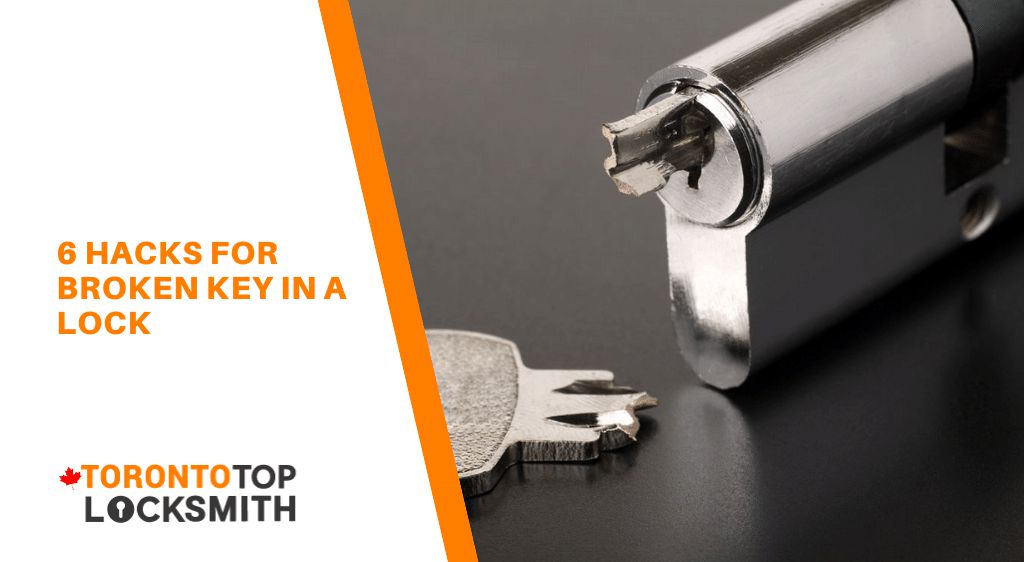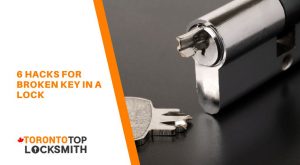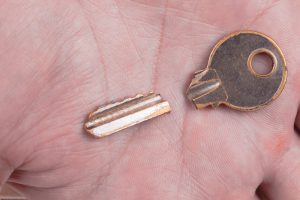

What to Do When Your Key Breaks Inside the Lock?
Broken keys are something a residential locksmith encounters on a regular basis. Consider the amount of pressure a key must withstand, it's no wonder they break eventually. Prevention is best and, if you notice that one of your keys is starting to bend, it's best to avoid using this key and either replace the lock, have it rekeyed, or have a new key cut. Keys should only be copied from original keys that are in very good condition. Otherwise, any defects will simply be carried over to the new key. If, for whatever reason, you end up with a broken key stuck inside a lock, here are some things you can try.
Do NOT use the key again!

If the key has broken off inside the lock, there really is no point in trying to stick the remaining key in again. All you are doing is moving the broken piece around and probably making things worse. If you push the broken piece further into the lock, it will be even more difficult to remove. Therefore, resist this urge and take a moment to consider other options.
Do you have tweezers?
The effectiveness of this method depends on how far the key has lodged itself inside as well as the thickness of the tweezers. Some may fit in the lock but, if you cannot open them to grasp the key, they can’t do much good. Smaller tweezers can prove successful at removing broken keys that are within relatively close reach. If the key is really stuck, your tweezers might not give you sufficient grip. This method will require time and patience.
Key extractor
If you happen to have this professional tool at home, then it's your best bet. However, broken key extractors are usually tools of a professional residential locksmith which means that most of us aren't so lucky. This tool is quite easy to use and you need to grab the key with the extractor hooks before removing it slowly. You might not succeed during your first try so be patient. If you want to buy this tool, remember that there are many different variations on the market. Consider the practicality of the tool before buying it.
Blade from your jigsaw
You can make a key extractor using a small jigsaw blade. The blade needs to be as small as possible since it needs to fit inside the keyhole. You can break the blade using some pliers. The serrated edge is the part you need to hook the key. Once inserted, turn the blade so that it catches the key, and gently pull to remove the key. This is a great option if you have blades on hand or if you can at least make your way to a nearby hardware store.
Super Glue
This one can be particularly tricky and risky too. This is a method that fails more often than it succeeds which is why so many people prefer to call their local residential locksmith instead! This method should only be used if the key is not stuck far inside the lock.
Cylinder tapping
You will need to be able to point the keyhole down. This is most effective for padlocks or if you can remove the cylinder. Strike the lock with your hammer while keeping the lock very still. The force of the hammer and gravity will work together to loosen the key. Remember, if you do use this method, you will need to have a residential locksmith check the lock core for any damage. If you don't repair this damage, the lock can give you more trouble later.
Probe around
Use two thin pieces of metal to probe around for the broken key. You will need to line up a piece of metal on either side of the key before applying plenty of pressure to it. Slowly remove the key. You might need to do so bit by bit since you could lose your grip several times. Take your time and be prepared for the picks you use to bend slightly during this process. This is why you should use old or inexpensive tools.
All of these methods require care, patience, and time. Trying to work quickly can only make matters worse. If you want to save yourself the trouble it is best to contact a residential locksmith in your area. Toronto Top Locksmith offers speedy emergency residential locksmith services and we always arrive promptly to assist. Call us anytime at (647) 479-7764. We usually arrive within 20 minutes of receiving your call.
Check out our other lock emergency tips:
Can a locksmith cut a key from a lock?
What to do if a doorknob turns but the door does not open
Most common locksmith emergencies in Toronto

